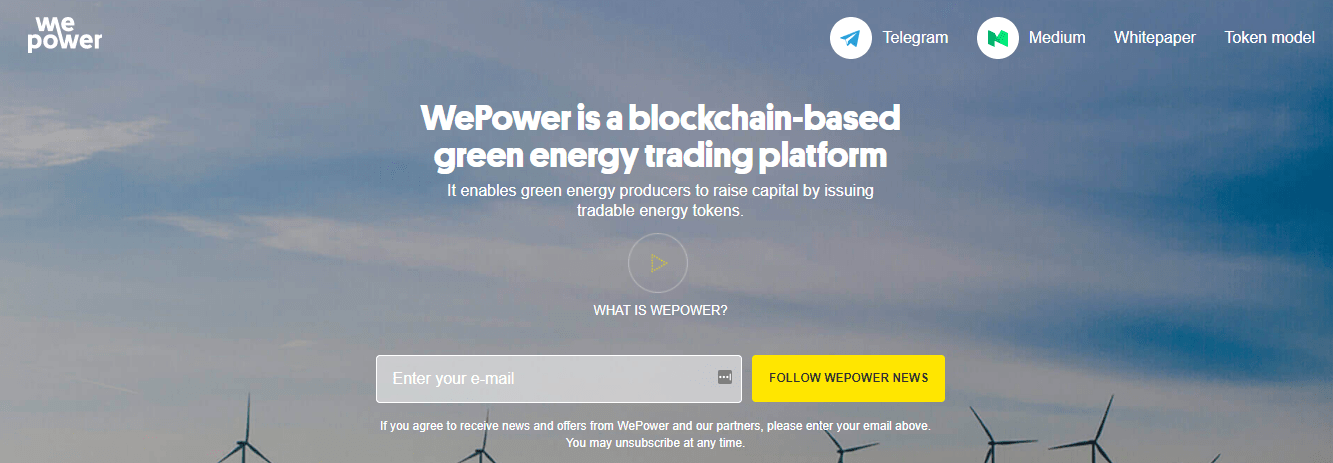According to statistical studies, the renewable energy sector has drawn in a total investment of over US$242 billion till date. However, investments have dipped recently due to a lack of access to capital funds. Owing to the domination of banks, private equities, and hedge funds, investors are kept out of the energy market, thereby causing a gap within the supply-demand chain for renewable resources.
WePower is an all-new blockchain-based green energy trading platform designed to tap into the existing energy market in a way that allows for optimal resource utilization.
WePower essentially acquires 0.9% of all energy that has been enabled through the platform to its token holders. These native coins (WPR tokens) are then used to accrue green energy that has been donated by renewable resource producers.
As a result, WPR token holders have the ability to use or sell the donated green energy once it has been produced.
Additionally, this system provides renewable energy producers with a platform for raising capital by issuing their own tokens. These tokens can be thought of as representations of the amount of energy one would like to commit to produce and deliver.
Overview of WePower
- Allows for energy tokenization that helps simplify the existing energy investment ecosystem
- Eliminates the need for middlemen, and allows energy producers to directly trade with green energy buyers
- The platform can be used to raise capital by selling energy upfront. This can even be done at rates well below the existing market prices, thereby increasing healthy competition
- Makes use of an innovative transmission system that is driven by individual operators
Key features
WePower is an energy trading platform that bridges the gap that currently exists between energy buyers — householders and investors — and green energy producers. Consequently, it helps customers purchase energy upfront at prices well below the existing market rates.

Key features of the WPR business model
It should also be mentioned that WePower makes use of an energy tokenization model that helps standardize, simplify, and open up the energy investment ecosystem. Not only that, but tokenization also helps ensure liquidity and improves capital access for users.
Additionally, the platform uses a scalable framework that will allow it to integrate with the IoT model.
Lastly, WePower serves as an independent energy supplier. This allows the platform to mesh within the energy grids that are used by local energy exchange markets. WePower makes use of real-time tracking modules that help procure data on produced and consumed energy, as well as on current rates from various energy grids and exchange markets.
How WePower works
For starters, once a renewable energy producer has been connected to the platform, all of his or her future energy production is tokenized. To be more specific, each kWh unit that is received by the company is converted into one internal energy token.

Overview of how the WePower platform works (courtesy of the whitepaper)
Thus, when a producer requires capital to finance his or her project on a larger scale, he or she is given the option to sell a portion of the energy that he or she will produce in the future to the WePower platform.
It should be noted that investors acquire all of this energy in the form of internal tokens, with each coin representing a smart contract unto itself. The smart contract is automated and comes with predefined information pertaining to:
- The type of energy being delivered
- A time-stamp describing the production and delivery date for the energy
- An immutable price tag
Additionally, this digital contract also represents a standard power purchase agreement that helps eliminate any issues related to sudden price hikes or supply disputes that may arise at a later stage.
About the project
With the WePower platform promising big things in the future, it is important to have a look at the people running this operation.
At the helm, we have Nikolaj Martyniuk, who is the company’s co-founder and CEO. Nikolaj has been in the international renewable energy domain for a decade and has previously worked with a wide array of independent energy suppliers. He is also one of the founding partners of Smart Energy Fund.
Artūras Asakavičius is also a co-founder with a background in regulation and fintech. He has worked with an array of lawyers, blockchain businesses, as well as law firms in the past. Artūras is also the former chairman of the Lithuanian Fintech Association.
Lastly, Kaspar Kaarlep is the CTO of this venture. He has previously worked in a similar position for a national DSO whose aim was to help integrate green energy into smart grids. Kaspar is also a well-known speaker at various European conferences, with his talks focusing on domains such as energy system digitalization and implementation of big data analytics.
Token Performance
Released in February of this year, the price of WPR tokens has remained relatively stable. Due to its newness, it is difficult to assess the future price performance of this currency.

WPR token lifetime performance chart (courtesy of CoinMarketCap)
WPR was introduced at a rate of US$0.20. The token hit its peak value on the 26th of February when the price of one WPR scaled up to US$0.28. Since then, its price has dropped and the currency now stands at US$0.11 (as of March 14).
Final Thoughts
WePower offers a platform that can potentially help usher in the next generation of utility companies that are based entirely on the principles of decarbonization, democratization, and decentralization.
By combining elements of blockchain, smart contracts, and data analytics, WePower can mold the future of this planet in a direction that will not only help save natural resources but also help create more social awareness.
If you would like to start investing in WePower, WPR trading pairs are currently being offered on Huobi, Liqui, IDEX and Fork Delta.

